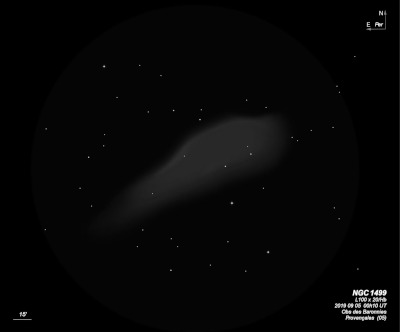California Nebula
California Nebula

13x80mm (1/13/07): excellent view in my 80mm finder using a 24mm Panoptic and an H-beta filter as a huge, elongated bar of fairly high contrast stretching across the field. The glow is generally brightest in the broad middle section between Xi Persei and the 6th magnitude star off the central north side. The nebula noticeably tapers towards the southeast end as the northern side of this end squeezes inward. Similarly, the northwest end also tapers as the northern boundary narrows towards the southern side.
16x80mm (7/27/84): very large and faint, very elongated WNW-ESE, sharper and brighter on WNW edge, very low surface brightness. Improved contrast with an H-beta filter.
15x50mm IS binoculars (8/27/11): very faintly visible as a large, elongated glow near Xi Persei using a pair of 2" H-beta filters over the objectives.
E.E. Barnard discovered NGC 1499, the California Nebula, on 3 Nov 1885 while searching for comets with the 6-inch Cooke Equatorial refractor at Vanderbilt University Observatory. In the Sidereal Messenger (Vol 5, p27), he reported "this requires the lowest power and cannot be seen by direct vision. It is only by directing the vision slightly to one side of its place that it is pssible to see it, then flashes out feebly." The NGC position is near the following end.
Simon Archenhold produced the first photograph on 27 Oct 1891. He quickly published an article with a sketch of the outline (nearly 2?) and apparently felt it was too large photographically to be identical to Barnard's intended object. Barnard responded in an 1894 article that he discovered this object visually and published a photographed taken in 1895 with the Willard lens in Astrophysical Journal, 2, 350.
300/350mm - 13.1" (1/18/85): definite contrast gain with H-beta filter as only the section NW of Xi was definite using a Daystar 300 filter (siimlar to UHC), but the H-beta shows the full extent easily.
400/500mm - 17.5" (1/16/02): Despite its reputation as a challenging target, this was an easy, fascinating object at 64x with a H-beta filter. The California Nebula is HUGE and extended a full two eyepiece fields even using a 31 Nagler for a total length of over 2.5 degrees and with a varying width of 15'-30', extended WNW-ESE. The E-W border is well-defined with a filter, particularly in the general vicinity of Xi Persei (middle of three naked-eye stars in the leg of Perseus collinear with the Pleiades) on the southern border and a long straight stretch on the northern edge. Along the northern edge, there is some filamentary, wispy structure similar to the view of the Veil nebula in a small scope!
The nebulosity is weaker and more disorganized, though, close to the preceding and following ends. The nebula tapers towards the eastern end where there are some additional brighter streaks and dark intrusions near a group of stars. Portions of the central region are clearly fainter with no evident structure. At the west end the structure is also chaotic with an irregular mix of weak nebulosity and darker voids. There is much to view here even at 64x, and I spent 30 minutes scanning the entire length for structure.
17.5" (10/28/89): the California Nebula requires very low power and visibility is best using an H-beta filter. At 82x appears very large, faint, very elongated, irregular low surface brightness with darker lanes and some wispy structure along the edges. The most well-defined section of the border is near a mag 8.5 star bordering the southern edge. Located roughly 30' N of mag 4.0 Xi Persei.
Notes by Steve Gottlieb